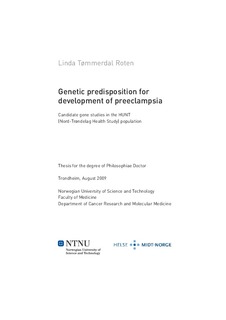| dc.contributor.author | Roten, Linda Tømmerdal | nb_NO |
| dc.date.accessioned | 2014-12-19T14:18:00Z | |
| dc.date.available | 2014-12-19T14:18:00Z | |
| dc.date.created | 2009-09-21 | nb_NO |
| dc.date.issued | 2009 | nb_NO |
| dc.identifier | 236125 | nb_NO |
| dc.identifier.isbn | 978-82-471-1705-7 (printed ver.) | nb_NO |
| dc.identifier.isbn | 978-82-471-1706-4 (electronic ver.) | nb_NO |
| dc.identifier.uri | http://hdl.handle.net/11250/263374 | |
| dc.description.abstract | Preeclampsia is a major cause of maternal morbidity and mortality in the western world, and approximately 63,000 women dye yearly of the disease worldwide. This disorder is characterized by increased maternal blood pressure (hypertension) and proteinuria, sometimes also with edema. The clinical manifestations develop during the latter half of the pregnancy. However, preeclampsia is a condition which may aggravate very quickly, from minor (mild hypertension and traces of protein in the urine) to life-threatening manifestations. Generally, preeclampsia manifestations are maternal, but sometimes the fetus is also involved. The most important fetal sign is growth restriction, due to an insufficiently developed placenta and reduced supply of oxygen and nutrition. Unfortunately, women who develop preeclampsia have an increased risk of loosing their baby prior to, during or immediately after birth. Preeclampsia lacks an effective prevention strategy or curative treatment, and if the preeclamptic manifestations threaten maternal or fetal life, the only alternative is to deliver the baby and placenta, irrespective of gestational age. This implies preeclampsia as one of the most important causes of premature delivery.
Preeclampsia may be heritable, and some families show an increased occurrence of the disease. By studying such families, it was discovered that development of preeclampsia is influenced by the genetic material/genes. Genetic mechanisms and risk factors are obviously included in development of this disease, however it is still unclear which, what their influence is and how they work together with other mechanisms or risk factors. The genetic component was initially ascribed to maternal inheritance, but it has later turned out that both mother and fetus (via paternal genes) contribute to the genetic risk of developing preeclampsia. But the genetics of preeclampsia are complex and shares characteristics of common complex diseases such as cardiovascular diseases and diabetes. These diseases are characterized by no clear-cut and distinct pattern of inheritance, and it is the effect of many genes in combination with lifestyle and environmental factors that contribute to the risk.
Whole genome scans (linkage analyses) have been used to map genetic loci that predispose to disease in families with increased occurrence of preeclampsia. These families are likely to have a strong genetic predisposition. In addition, it is easier to search for regions in linkage with disease by comparing affected and unaffected individuals that are related since relatives are very much alike genetically (in their DNA). Although these family studies have been successful in identifying chromosomal regions in linkage with disease, it has proven difficult to identify the actual genes predisposing to preeclampsia. Thus, this is still one of the fundamental and important challenges in obstetrics.
| nb_NO |
| dc.language | eng | nb_NO |
| dc.publisher | Norges teknisk-naturvitenskapelige universitet, Det medisinske fakultet, Institutt for kreftforskning og molekylær medisin | nb_NO |
| dc.relation.ispartofseries | Doktoravhandlinger ved NTNU, 1503-8181; 2009:157 | nb_NO |
| dc.relation.ispartofseries | Dissertations at the Faculty of Medicine, 0805-7680; 399 | nb_NO |
| dc.title | Genetic predisposition for development of preeclampsia: Candidate gene studies in the HUNT(Nord-Trøndelag Health Study) population | nb_NO |
| dc.type | Doctoral thesis | nb_NO |
| dc.contributor.department | Norges teknisk-naturvitenskapelige universitet, Det medisinske fakultet, Institutt for kreftforskning og molekylær medisin | nb_NO |
| dc.description.degree | PhD i molekylærmedisin | nb_NO |
